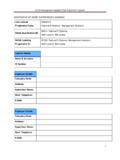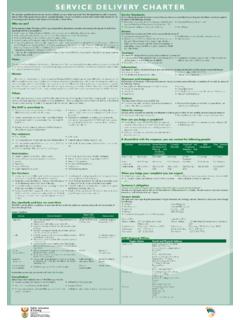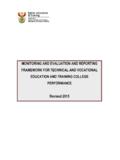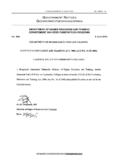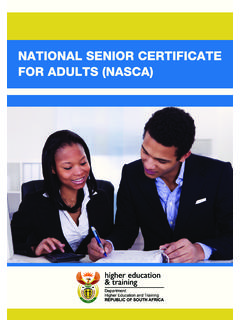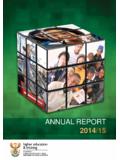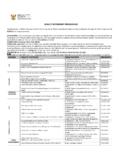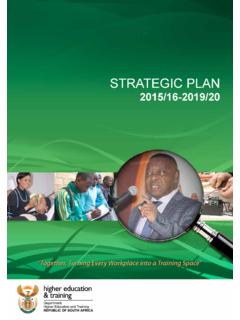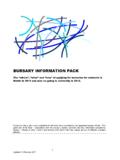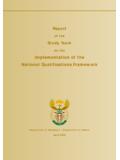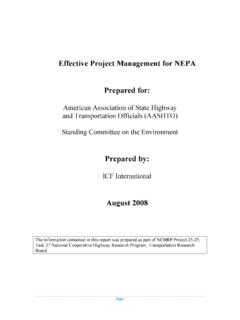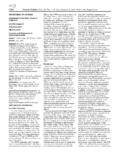Transcription of Education in South Africa: Achievements since 1994 ISDN 0 ...
1 Education in South africa : Achievements since 1994 . ISDN 0-970-3911-2. Department of Education May 2001. CONTENTS. Education Change and Transformation in South africa : .. A Review 1994 -2001 .. Preface and introduction by the Minister of Education , Professor Kader Asmal .. 1. Education change and transformation: key strategic shifts 1994 -2001. 2. Innovation and change in Education : laying the foundation of the post-apartheid Education and training system .. 3. Innovation and change in Education : transforming learning and 4. Innovation and change in Education : building a nationally co-ordinated and planned higher Education system.
2 5. Innovation and change in Education : implementing the Human Resources Development Strategy of South Vision, mission and objectives of the 6. HIV/AIDS .. 7. Partnerships and international 8. Building an Education and training system for the 21st century: Future challenges .. Bibliography .. Acronyms ABET Adult Basic Education and Training AIDS Acquired Immune Deficiency Syndrome C2005 Curriculum 2005. CEM Council of Education Ministers CHE Council on Higher Education COLTS Culture of Learning, Teaching and Service DoE Department of Education EDSU Education Departments Support Unit EMD Education Management Development EMGD Education Management and Governance Development EMIS Education Management Information Systems FET Further Education and Training FETC Further Education and Training Certificate GEAR Growth.
3 Employment and Redistribution GETC General Education and Training Certificate HE Higher Education HEDCOM Heads of Education Departments Committee HRD Human Resource Development IPET Implementation Plan for Education and Training LSM Learning Support Materials MTEF Medium Term Expenditure Framework NEPA National Education Policy Act NEPI National Education Policy Investigation NGO Non-governmental Organisation NPDE National Professional Diploma in Education NQF National Qualifications Framework PRF Policy Reserve Fund SACE South African Council of Educators SAQA South African Qualifications Authority SASA South African Schools Act SCE Senior Certificate Examination SRN School Register of Needs Preface and introduction by the Minister of Education , Professor Kader Asmal The last decade of the 20th century in South africa , as we noted in the Implementation Programme for Tirisano 2001/2, will always be associated with the country's first national democratic elections.
4 In April 1994 , centuries of struggle against colonial and apartheid rule culminated in a peaceful transition to democracy. Fear was replaced by hope, repression by democratic freedom, exclusion and division by the possibilities of inclusiveness and unity. A massive national project to take down the scaffolding of apartheid and replace it with a system that promised well being, respect, and expression for all South Africans began. The project challenged us to rethink every aspect of our nation, from concepts of democracy, justice and prosperity, to the Constitution and its expression in policies, law and management.
5 It challenged us nationally and personally to reconstruct our basic understanding of what it means to be South African. The profound changes taking place globally during this same period framed our national project. As a nation, we took a conscious decision to understand the emerging form and function of globalisation, and locate our country as a competitive economy within this context. At a time when many observers were proclaiming the end of the nation state, we embarked upon a project that strongly asserts the responsibility of the government, in partnership with civil society, to develop a framework and environment for the emergence of a new national character.
6 At a time of global homogenisation' we committed ourselves to reclaiming our history and culture as the solid foundation for building a sense of meaning and vision for our people. We have sought to understand our specific geographic, economic, and cultural placement as a nation in Southern africa , on the African continent, and within the South ', in a global world where power and wealth are unequally distributed. This report reviews and assesses educational transformation in South africa since the 1994 elections. Educational reform has been a central part of the country's reconstruction and development project.
7 It has been driven by two imperatives. First, the government had to overcome the devastation of apartheid, and provide a system of Education that builds democracy, human dignity, equality and social justice. Second, a system of lifelong learning had to be established to enable South Africans to respond to the enormous economic and social challenges of the 21st century. This paper outlines the government's efforts to address and reconcile these two imperatives in the first seven years of post-apartheid rule. Section 2 of the paper reviews the key shifts in policy and practice in the last seven years.
8 The first period of Education reform had as its central task replacing minority rule, balkanised, racially resourced organisations, institutions and governance, with a democratic order marked by non-racialism and non-sexism. We sought to establish visionary policies, new organisations, institutions, governance structures, and resourcing patterns, supported by a sound legislation. The second period deepened systemic reform through the Tirisano programme, where key policy goals, undergirded by sets of targeted and prioritised interventions, aimed for stronger accountability for performance and delivery across the system.
9 The third phase, having met some of the key challenges of systemic reform, is now focused on creating greater equity and quality of learning conditions, and improving standards and learner outcomes. A key feature of this phase is the deepening reform of institutional processes in all sectors. Section 3 highlights the key pillars of systemic transformation - the establishment of inter-governmental forums and co-operative governance, and resource allocation. Section 4 presents our progress in transforming learning and teaching, through principles of lifelong learning, the National Qualifications Framework (NQF), curriculum transformation, values in Education and systemic quality.
10 Section 5 overviews innovation and change in our higher Education system and reviews the policy goals we had outlined for ourselves in Education White Paper 3 and the legislative and regulatory framework we created through the Higher Education Act in the first period. It then looks at the subsequent period of developing the plans for higher Education restructuring which are now outlined in the National Plan for Higher Education . Section 6 outlines the newly launched Human Resource Development Strategy for South africa , a collaborative effort between the Departments of Education and Labour.
